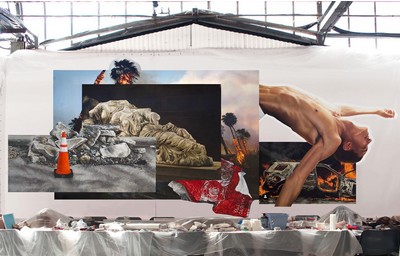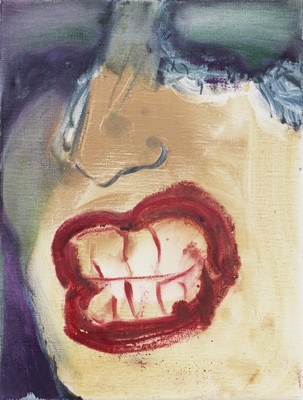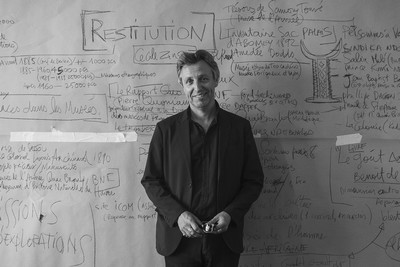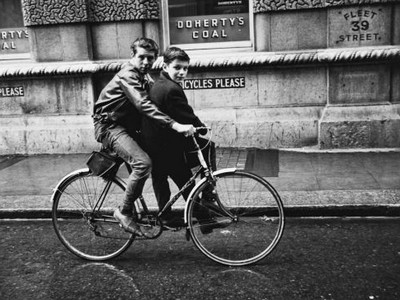Olga de Amaral: To Weave a Rock
Museum of Fine Arts, Houston
July 25 - September 19, 2021
Brumas (Mists), 2013
Acrylic, gesso, and cotton on wood
Courtesy of the artist
© Olga de Amaral / Photograph © Diego Amaral
The Museum of Fine Arts, Houston, presents Olga de Amaral: To Weave a Rock, the first major touring retrospective of the prolific, visionary Colombian artist whose pioneering visual language has helped to transform the fiber arts movement. Co-organized by the MFAH and the Cranbrook Art Museum, the exhibition traces Olga de Amaral’s architectural investigations of the woven form through some 50 works created during the past six decades, ranging from her early Muros (Walls) series to the more recent immersive installation Brumas (Mists).
“This retrospective allows audiences to see the six decades of my work side by side for the first time,” Olga de Amaral said. “To have it open at the Museum of Fine Arts, Houston, is a great honor, as they hold leading collections in both decorative arts and Latin American art in the United States. The exhibition was also co-created with Cranbrook Art Museum, the museum of my alma mater, Cranbrook Academy of Art, which is such an important part of my creative history and where I met my husband, the artist Jim Amaral. This retrospective and publication have been years in the making, and I feel they are a wonderful showcase of my life’s work.”
An “alchemist artist,” Olga de Amaral has experimented radically with material, composition, and space, transforming flat-woven tapestries into forms that defy the confines of any genre or medium. Co-curators Anna Walker, Assistant Curator, Decorative Arts, Craft, and Design at the MFAH; and Laura Mott, Senior Curator of Contemporary Art and Design at Cranbrook Art Museum, chronicle Amaral’s career through four thematic sections: “Radical Materialism,” “Rebel Warp,” “Alchemy,” and “The Line.” They also devote two galleries to the artist’s immersive Brumas (Mists) and Estelas (Stele) series.
“Olga de Amaral is a leading figure who continues to push the boundaries of the fiber arts movement. Deeply rooted in her Colombian heritage and architectural training, Amaral’s sculptures command our attention with their exploration of color, texture, and structure,” said Gary Tinterow, Director, the Margaret Alkek Williams Chair, MFAH. “We are delighted to partner with the Cranbrook Art Museum to present this comprehensive survey and highlight Amaral as a seminal artist of the last 60 years.”
“Amaral has developed a language all her own within the fiber arts movement through experimentation with the loom and her transformational use of materials,” Walker said. “The MFAH has established the most comprehensive collection of her work in North America. It’s a thrill to present these works alongside other important examples that exemplify her creative spirit.”
Exhibition Overview
After earning an architectural drafting degree in her native Bogotá, Colombia, Olga de Amaral (born 1932) attended the fabric and design weaving program at Michigan’s Cranbrook Academy of Art in the mid-1950s. There, she studied under the renowned Marianne Strengell, who emphasized textile design’s relationship with interior space and its use as an architectural material. When she returned home, Amaral applied Strengell’s philosophies to woven works that also were informed by her environment.
• “Radical Materialism” explores Olga de Amaral’s unconventional use of horsehair, wool, gold leaf, plastics, and other materials that reflect the landscape and culture of Colombia while also utilizing texture, color, and light to create dimensionality and structure. A notable example, the Luz (Light) series from the mid-to-late 1960s, features tapestries of cascading, layered polyurethane that depict water flowing across the Colombian terrain.
• The “Rebel Warp” section illustrates how Olga de Amaral has investigated scale and challenged traditional weaving traditions with innovative plaiting, wrapping, coiling, and warp manipulation. The parallel rods of her groundbreaking series Muros tejidos (Woven Walls) support vertical, lattice-like loops to form distinct structures and shapes; principles she also applied to free-standing sculptures such as Columna en pasteles (Column in Pastels) (1972).
• Embracing the spiritual significance of gold in Colombian culture, Olga de Amaral has made gold leaf a signature material. The “Alchemy” section presents selections from Alquimia (Alchemy), her acclaimed 1980s series of wall-hung tapestries composed of individually woven linen squares lacquered with gesso and gold leaf. Also especially notable are works from Amaral’s immersive series Estelas (Stele), whose suspended structures evoke upright stones.
• The works of “The Line” section incorporate painted, free-hanging threads. Highlights include pieces from the Nudo (Knot) series, whose long, loose linen fibers anchored with knots resemble monumental, draped tassels of magenta, turquoise, and gold. Another work, Agujero Negro (Black Hole) (2016) initially suggests a black void painted on gray fringe, but as viewers pass by, threads waft to reveal a sliver of gold paint that glimmers like sunlight. The immersive Brumas (Mists) (2013), a series of three-dimensional, suspended forms, engulfs viewers in vibrant colors and geometric shapes.
ToWeave a Rock
Exhibition Catalogue
Publication: This exhibition is accompanied by a fully illustrated catalogue, Olga de Amaral: To Weave a Rock, authored by co-curators Laura Mott and Anna Walker and co-published by the Museum of Fine Arts, Houston, and Arnoldsche Art Publishers.
Olga de Amaral: To Weave a Rock was organized by the Museum of Fine Arts, Houston, and the Cranbrook Art Museum. After Houston it will traveling to the Cranbrook Art Museum in Bloomfield Hills, Michigan, in October 2021.
MUSEUM OF FINE ARTS HOUSTON - MFAH
1001 Bissonnet, Houston, Texas 77005











